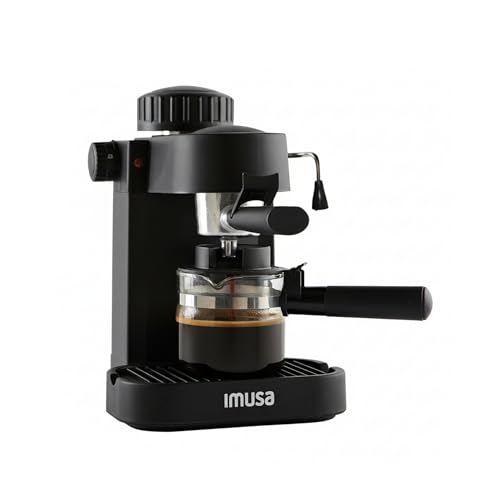When that afternoon energy crash hits or we need a quick caffeine boost before a meeting, nothing beats the convenience of instant espresso. This beloved Italian-inspired drink delivers the bold, concentrated flavor we crave without the need for expensive equipment or lengthy brewing processes.
Instant espresso has become our go-to solution for those moments when time is precious but our taste buds won’t settle for ordinary coffee. Unlike regular instant coffee, this concentrated powder packs a powerful punch that rivals freshly brewed shots from your favorite café. We’ve perfected this simple method that transforms a basic pantry staple into a rich, satisfying drink in under two minutes.
Whether you’re rushing out the door, working late, or simply want to enjoy authentic espresso flavor at home, this recipe will become your new secret weapon. Let’s jump into creating the perfect cup that’ll save you time and money while delivering that distinctive espresso experience we all love.
What You’ll Need for This Instant Espresso Recipe
Creating the perfect instant espresso requires just a few essential ingredients and basic equipment you likely already have in your kitchen. We’ve simplified this process to ensure you can enjoy rich espresso flavor without any complicated tools or hard-to-find ingredients.
Essential Ingredients
- 1-2 teaspoons instant espresso powder (we recommend brands like Medaglia d’Oro or Café Bustelo)
- 6-8 ounces hot water (between 195-205°F for optimal extraction)
- Sugar or sweetener to taste (optional)
- Milk or cream for texture (optional)
Equipment You’ll Need
The beauty of instant espresso lies in its simplicity. We only need basic kitchen tools that most coffee lovers already own:
- Coffee mug or espresso cup
- Measuring spoons
- Kettle or microwave for heating water
- Small spoon for stirring
Quality Matters
We always emphasize selecting high-quality instant espresso powder for the best results. Premium brands undergo freeze-drying processes that preserve more of the original coffee’s aromatic compounds and oils. This attention to quality creates a more authentic espresso experience that closely mimics the bold intensity of traditional brewing methods.
Water temperature plays a crucial role in extraction. We avoid boiling water as it can create bitter notes in your instant espresso. Instead we aim for water that’s just off the boil to unlock the full flavor profile of your instant espresso powder.
Ingredients
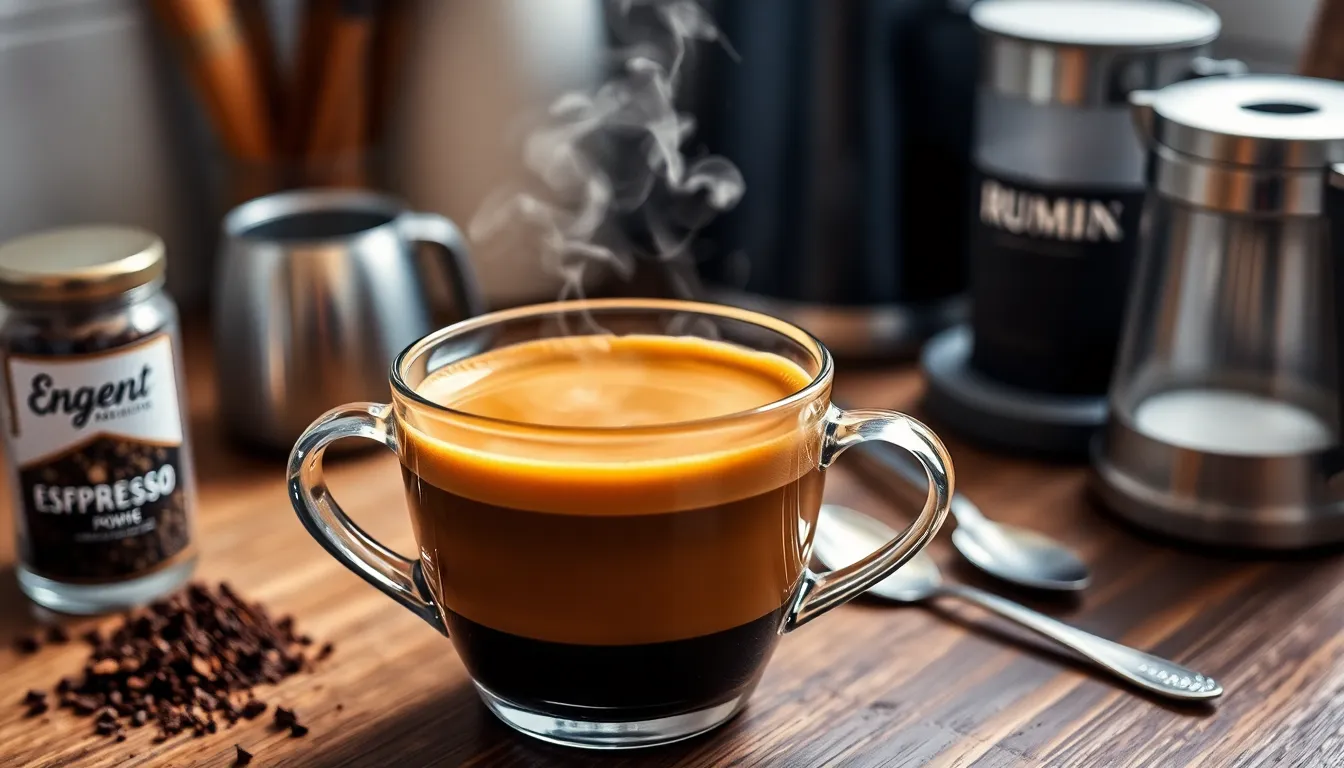
We need just a few simple ingredients to create our perfect instant espresso at home. The beauty of this recipe lies in its minimal requirements while still delivering maximum flavor impact.
For Basic Instant Espresso:
- 1 to 3 teaspoons instant espresso powder or instant coffee granules (adjust based on desired strength)
- 2 ounces hot water (about 4 tablespoons or 1/4 cup)
Optional Flavor Enhancers:
- Sugar or sweetener to taste
- Milk or cream for richness
- Brown sugar syrup for specialty variations
Our primary ingredient is instant espresso powder, which forms the foundation of this quick brewing method. Premium brands preserve more aromatic compounds from the original coffee beans, resulting in a richer and more complex flavor profile. We recommend starting with 1 teaspoon for a mild strength and gradually increasing to 3 teaspoons for those who prefer a bolder, more concentrated taste.
Water temperature plays a crucial role in our extraction process. We use hot water that’s just off the boil to properly dissolve the instant powder without creating bitterness. The 2-ounce measurement provides the ideal concentration ratio, giving us that authentic espresso intensity we’re seeking.
For those who enjoy customizing their coffee experience, we can easily transform our basic instant espresso into specialty drinks. Adding milk creates an instant latte, while brown sugar syrup opens the door to trendy cafe-style beverages like iced brown sugar shaken espresso lattes.
Equipment and Tools
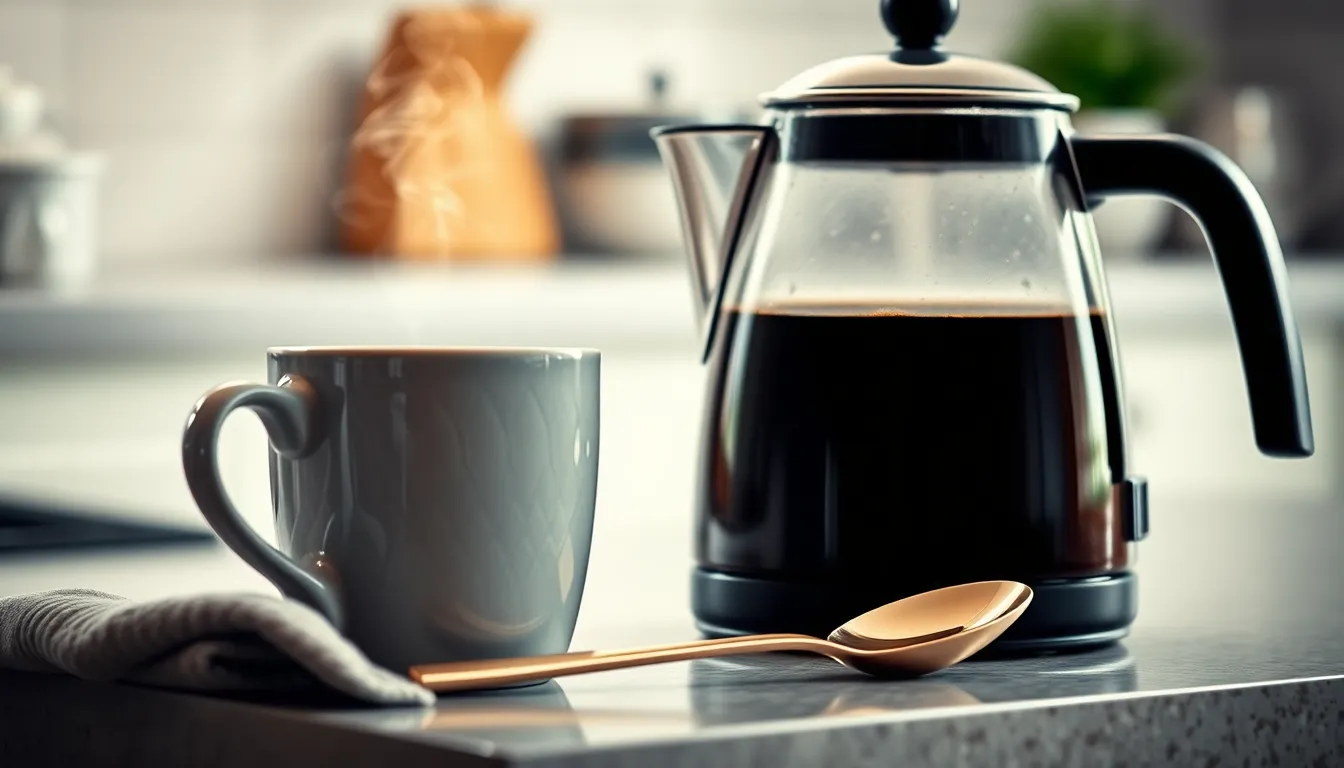
The beauty of instant espresso lies in its minimal equipment requirements. Unlike traditional espresso that demands specialized machines and accessories, we can create a satisfying espresso experience with just a few basic items.
Essential Equipment for Instant Espresso
Kettle or Water Heating Method: We need a reliable way to heat water to the optimal temperature. Any standard electric kettle, stovetop kettle, or even a microwave will work perfectly for this purpose.
Coffee Mug or Espresso Cup: Choose a heat-resistant vessel that holds at least 4 ounces. We recommend using a ceramic or glass mug that retains heat well and enhances the drinking experience.
Stirring Utensil: A teaspoon or small whisk ensures the instant espresso powder dissolves completely. Proper stirring prevents any gritty texture in our final drink.
Measuring Spoon: Accurate measurement of instant espresso powder makes the difference between a weak brew and a perfectly balanced cup. Standard measuring teaspoons work best for consistent results.
Optional Enhancement Tools
Milk Frother: For those who enjoy creamy textures, a handheld milk frother or French press can create foam similar to traditional espresso drinks. This simple addition transforms our instant espresso into a café-style beverage.
Digital Scale: While not necessary, measuring ingredients by weight rather than volume provides more consistent results. We can achieve precision that rivals professional baristas.
Thermometer: Water temperature affects extraction quality. A kitchen thermometer helps us maintain the ideal temperature range of 195-205°F for optimal flavor development.
Equipment Comparison Table
| Instant Espresso | Traditional Espresso |
|---|---|
| Kettle | Espresso Machine (130+ PSI) |
| Mug | Portafilter |
| Teaspoon | Tamper |
| Measuring spoon | Digital scale and timer |
| Optional: Milk frother | Adjustable grinder |
The stark contrast between equipment needs highlights why instant espresso appeals to busy coffee lovers. We can achieve satisfying results without investing in expensive machinery or dedicating counter space to bulky appliances. Our kitchen likely already contains everything needed to create the perfect instant espresso.
Instructions
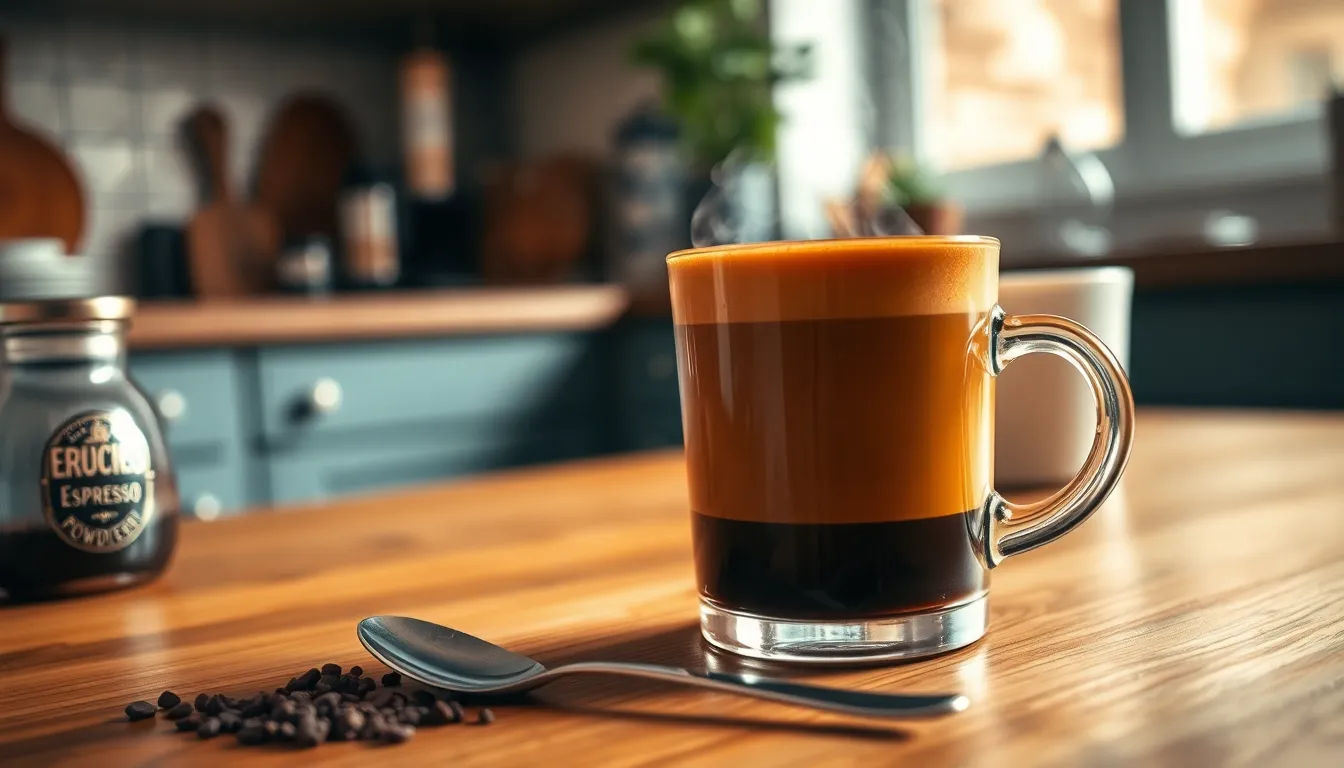
Creating perfect instant espresso requires following these precise steps to achieve maximum flavor extraction. Let’s walk through each phase of the brewing process to ensure your espresso delivers that rich, bold taste we’re after.
Prep Your Equipment
First, we need to gather our essential tools for the brewing process. Select a small espresso cup for an authentic experience or use a regular coffee mug if you prefer a larger serving size.
Keep a spoon or mini whisk within reach for thorough mixing. The stirring utensil ensures complete dissolution of the espresso powder and prevents any bitter clumps from forming in your final drink.
Heat the Water
Water temperature plays a crucial role in extracting the best flavors from our instant espresso powder. We want to use hot, steaming water that’s just off the boiling point to avoid any bitter notes.
Measure exactly 2 ounces of water, which equals about 4 tablespoons or ¼ cup. This precise measurement creates the perfect concentration for a true espresso strength beverage.
Measure the Instant Espresso
Accuracy in measuring ensures consistent flavor every time we make this recipe. Use exactly 1 tablespoon of instant espresso powder for the ideal strength and boldness.
This measurement provides the perfect balance between intensity and smoothness that characterizes quality espresso. Premium instant espresso brands will deliver more complex flavors at this ratio.
Mix and Serve
Place the 1 tablespoon of instant espresso powder directly into your chosen mug. The powder should sit at the bottom, ready for the hot water addition.
Pour the 2 ounces of hot water over the espresso powder in a steady stream. This technique helps begin the dissolution process immediately.
Stir vigorously with your spoon or mini whisk until the powder completely dissolves. We want no visible granules remaining in the liquid for the smoothest texture.
Serve immediately as a traditional espresso shot or use this concentrated base for creating lattes and cappuccinos. Optional additions like sugar, vanilla syrup, or cream can enhance the flavor profile according to your taste preferences.
Directions for Perfect Results
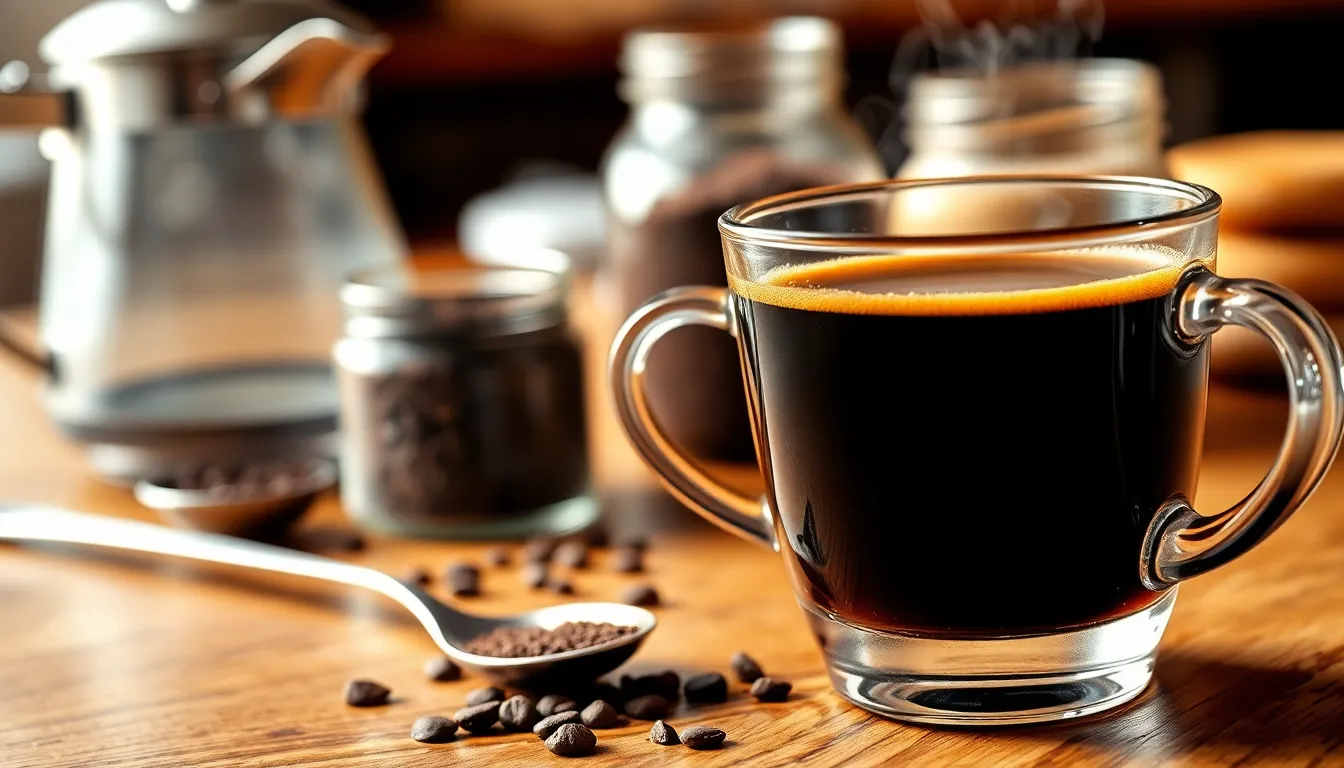
These essential techniques will transform your instant espresso from ordinary to extraordinary. Master these fundamentals to achieve that perfect concentrated flavor every time.
Getting the Water Temperature Right
Water temperature makes the difference between a mediocre cup and an exceptional espresso experience. We recommend heating water to the optimal range of 195°F to 205°F for the best flavor extraction from your instant espresso powder.
Steaming hot water just off the boil works perfectly when you don’t have a thermometer. Water that’s too cool fails to dissolve the powder completely while water that’s too hot can create unwanted bitterness. Let boiling water sit for 30 seconds before pouring to reach the ideal temperature range.
Achieving the Perfect Concentration
The standard ratio of 1 tablespoon instant espresso powder to 2 ounces of water creates that authentic espresso strength we all crave. This precise measurement delivers a concentrated shot that rivals traditional espresso machines.
Measuring exactly 2 ounces of water ensures your espresso maintains its boldness without becoming watery. Too much water dilutes the intensity while too little creates an overpowering bitterness that masks the coffee’s natural flavors.
Stirring Technique
Vigorous stirring with a small spoon or mini whisk ensures complete powder dissolution. We stir the mixture thoroughly until no powder granules remain visible at the bottom of the cup.
Proper stirring technique prevents that gritty texture that ruins an otherwise perfect espresso. Continue mixing for at least 15 seconds to achieve that smooth consistency that makes each sip enjoyable. The powder should disappear completely into the hot water creating a rich dark liquid.
Variations and Customizations
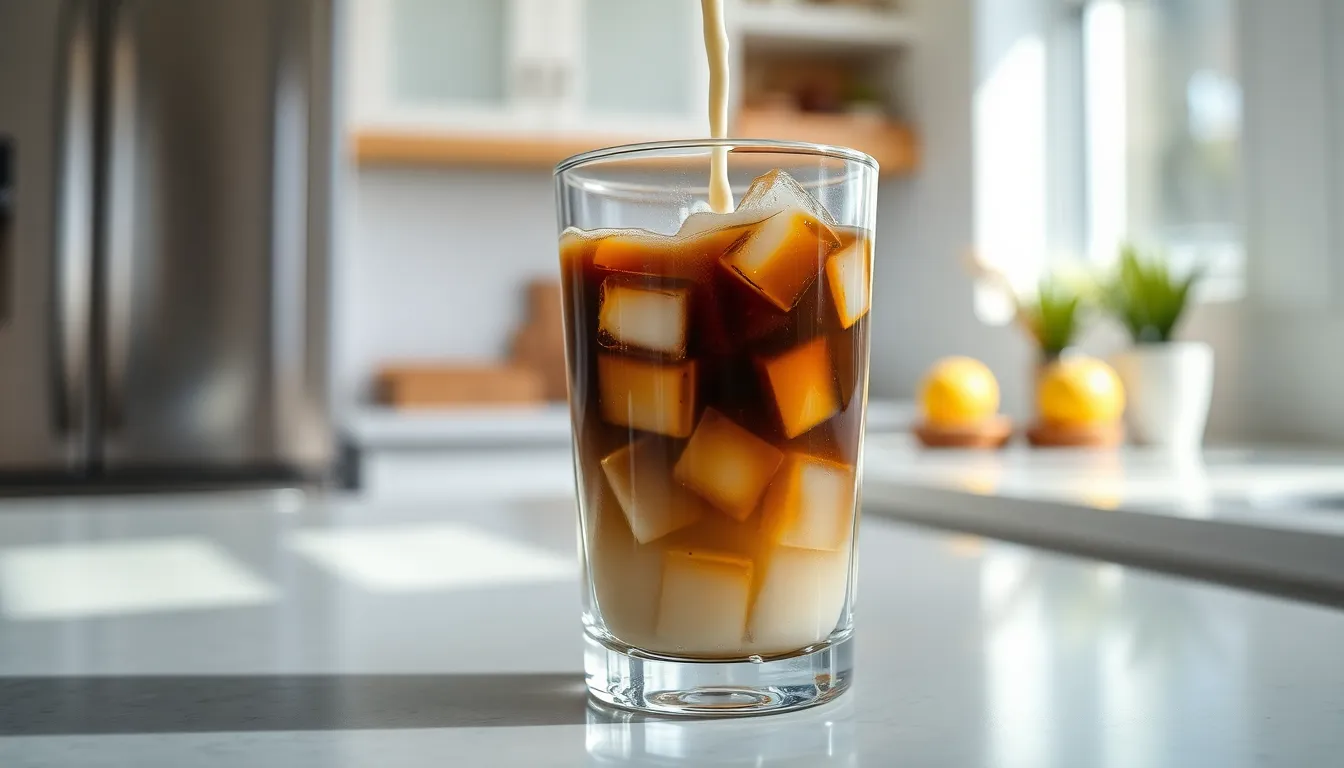
Now that we’ve mastered the basic instant espresso technique, let’s explore exciting variations that transform our simple recipe into café-style beverages. These adaptations allow us to customize our espresso experience based on personal preferences and seasonal moods.
Iced Instant Espresso
We create this refreshing variation by modifying our hot preparation method to accommodate cold serving temperatures. Start by dissolving 1-2 teaspoons of instant espresso powder in 2 tablespoons of hot water to ensure complete dissolution. Pour this concentrated mixture over a glass filled with ice cubes and add 6 ounces of cold water. The hot dissolution step prevents the powder from clumping when it meets the cold water. We can enhance the drink with milk or cream for added richness and smoothness. This variation works perfectly during summer months or when we need an energizing cold beverage.
Instant Espresso Latte
Our latte variation requires 1-2 teaspoons of instant espresso powder dissolved in 3 tablespoons of boiling hot water for the espresso base. Heat ½ to ¾ cup of milk using our preferred method until steaming but not boiling. Dairy milk creates the creamiest texture, though oat milk and other non-dairy alternatives work excellently for dietary preferences. Combine the dissolved espresso with the hot milk and stir gently to blend the flavors. We can add vanilla extract or a sprinkle of cinnamon to elevate the taste profile. This creates a smooth, café-quality latte that rivals expensive coffee shop versions.
Sweetened Instant Espresso
We transform our basic recipe into a dessert-like treat by incorporating sweeteners during the dissolving process. Add 1-2 teaspoons of sugar, honey, or maple syrup directly to the instant espresso powder before adding hot water. This ensures even distribution and complete dissolution of both the coffee and sweetener. Brown sugar creates caramel notes that complement the espresso’s boldness, while honey adds floral undertones. Vanilla extract works beautifully with any sweetener choice, requiring just ¼ teaspoon per serving. We can serve this variation hot for a comforting experience or pour it over ice for a sweet iced coffee alternative.
Storage and Make-Ahead Tips
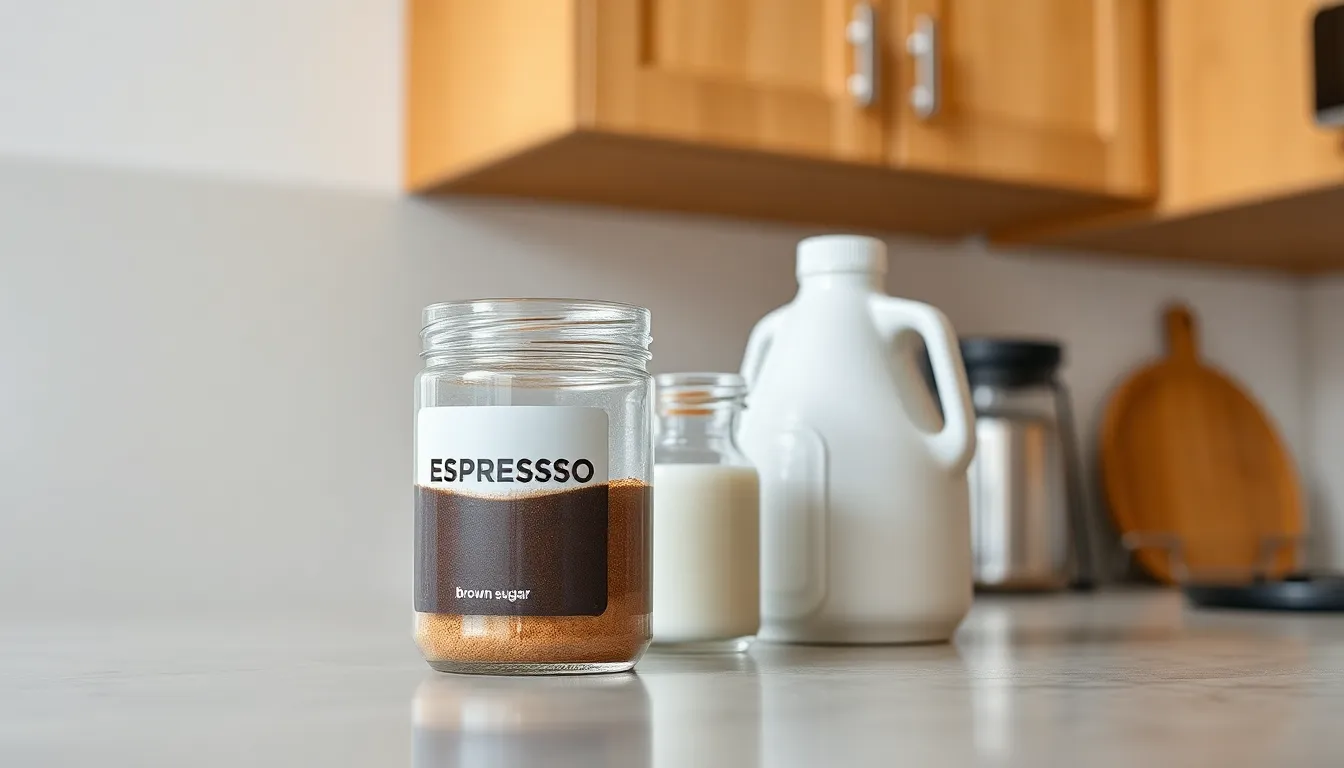
Maximizing the shelf life of our instant espresso ingredients ensures we always have a perfect cup ready when caffeine cravings strike. We recommend consuming prepared instant espresso immediately for optimal flavor since the liquid mixture deteriorates quickly when stored.
Proper Powder Storage
Store opened instant coffee or espresso powder in an airtight container within a cool dry place to maintain freshness and prevent clumping. This simple step preserves the aromatic compounds that give our instant espresso its rich flavor profile. We avoid storing the powder near heat sources or in humid environments like above the stove or near the dishwasher.
Separate Component Storage
Keep milk and syrup additions stored separately from the espresso powder for maximum flexibility. Prepared milk stays fresh in the refrigerator for up to 3 days while brown sugar syrup made with brown sugar cinnamon and boiling water maintains quality for up to a week when refrigerated.
| Storage Item | Location | Duration |
|---|---|---|
| Instant espresso powder | Cool, dry place in airtight container | Until expiration date |
| Prepared milk | Refrigerator | Up to 3 days |
| Brown sugar syrup | Refrigerator | Up to 1 week |
Time Saving Preparation Methods
Make brown sugar or flavored syrups ahead of time and store them in the fridge for quick use throughout the week. Pre-measure dry instant coffee or espresso powder in small airtight containers to speed up our morning routine. Store oat milk or other milk alternatives according to package instructions and keep them pre-chilled when possible for iced preparations. These make ahead strategies transform our instant espresso ritual from a two minute process into a 30 second pour and stir operation.
Troubleshooting Common Issues

Even with our foolproof instant espresso method, we occasionally encounter problems that can affect the final taste and texture. Understanding these common issues helps us achieve consistently excellent results every time we brew.
Bitter Espresso Answers
Bitterness remains the most frequent complaint we hear about instant espresso. Water temperature plays a crucial role in this problem. We recommend using water at 190°F to 195°F rather than boiling water to prevent extracting harsh compounds from the coffee granules. Our cold water bloom technique offers another effective solution: we add a small amount of cold water first to dissolve the powder completely before introducing hot water.
Weak Flavor Enhancement
Weak tasting espresso typically results from insufficient coffee powder or inadequate water temperature. We suggest increasing the instant coffee amount from 1 teaspoon to 2 or even 3 teaspoons for a bolder flavor profile. Using hotter water within our recommended range also helps extract more flavor compounds from the coffee granules.
Preventing Gritty Texture
Undissolved coffee granules create an unpleasant gritty texture that ruins the drinking experience. We combat this issue by stirring vigorously for at least 30 seconds until the mixture appears completely smooth. Our paste method works exceptionally well here: we create a thick paste with minimal hot water first, then gradually add the remaining liquid while stirring continuously.
Eliminating Foam Issues
Excessive foam can indicate over-agitation or incorrect water temperature. We control foam formation by using gentler stirring motions once the powder dissolves completely. But, if we desire a foamy texture, our whipping method creates intentional foam by vigorously whisking the coffee paste before adding the remaining water slowly.
Temperature Consistency Problems
Inconsistent serving temperature often stems from using cups that absorb heat quickly. We recommend preheating our espresso cups with hot water before brewing to maintain optimal serving temperature. Serving immediately after preparation ensures we capture the full flavor intensity and proper temperature.
Serving Suggestions
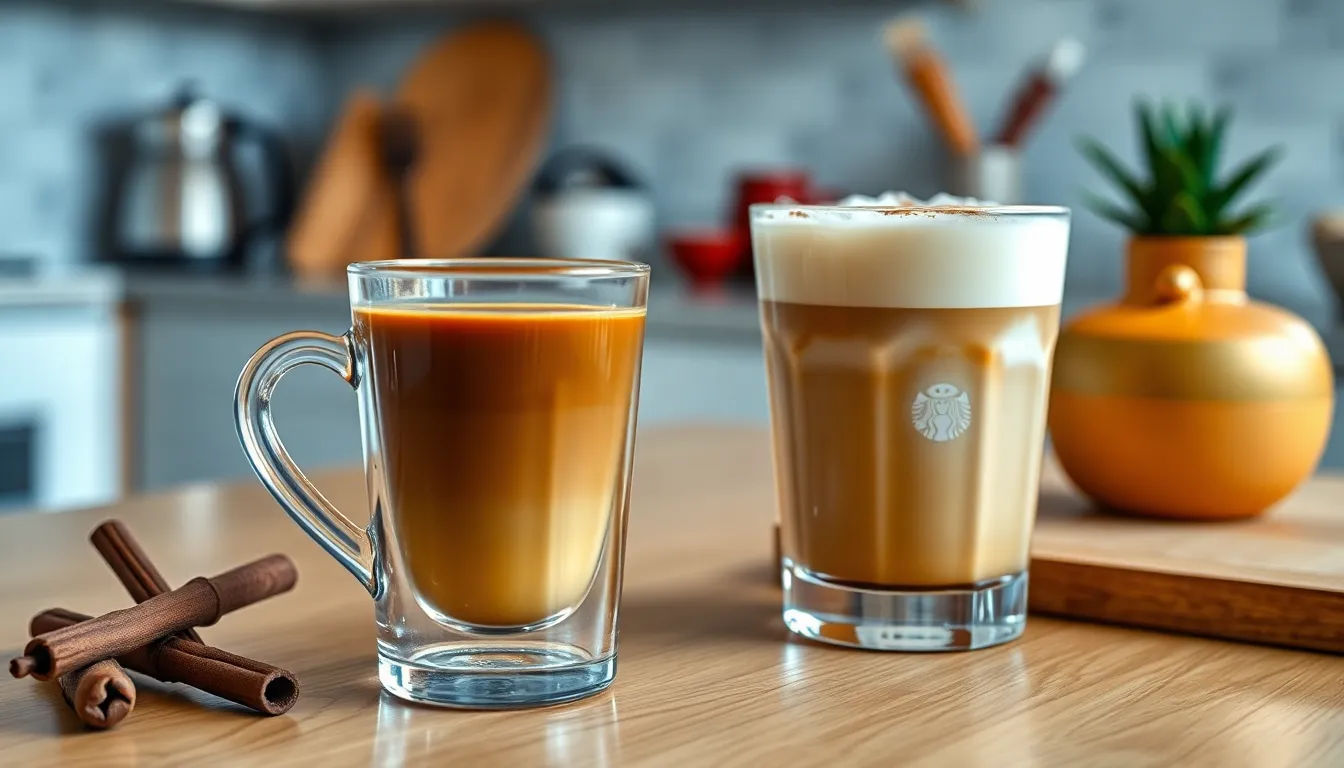
Our perfectly crafted instant espresso opens up countless possibilities for creating café-quality beverages at home. We can transform this concentrated base into many specialty drinks that rival those from expensive coffee shops.
Classic Espresso Shot
We recommend serving our instant espresso as a traditional shot for the most authentic experience. Pour the dissolved espresso into a small 2-ounce espresso cup and enjoy immediately while the flavors remain vibrant and aromatic. This concentrated serving method delivers the bold intensity that espresso lovers crave.
Instant Espresso Latte
Transform our basic recipe into a creamy latte by combining the prepared espresso with your choice of milk. We suggest using 6 to 8 ounces of steamed milk, oat milk, or any non-dairy alternative. Add sweeteners like sugar or flavored syrups to taste for a personalized touch.
| Latte Variation | Espresso Base | Milk Amount | Optional Additions |
|---|---|---|---|
| Classic Latte | 2 oz instant espresso | 6-8 oz steamed milk | Sugar, vanilla syrup |
| Oat Milk Latte | 2 oz instant espresso | 6-8 oz oat milk | Cinnamon, honey |
| Nescafe Style Latte | 2 oz Nescafe Gold Espresso | 6 oz combined milk and oat milk | Brown sugar |
Refreshing Iced Variations
We can create stunning cold beverages by pouring our prepared instant espresso over ice. For an iced latte, combine the hot espresso with cold milk or oat milk immediately after adding ice. This method creates a beautiful layered effect while maintaining the coffee’s robust flavor profile.
Brown Sugar Shaken Espresso Latte
Our most popular specialty drink combines instant espresso with brown sugar syrup for a unique flavor experience. Mix the prepared espresso with 1 to 2 tablespoons of brown sugar syrup, add your preferred milk, then shake vigorously over ice until frothy. This technique creates a luxurious texture that mimics expensive coffee shop beverages.
Creative Flavor Combinations
We encourage experimenting with various flavor enhancers to customize each serving. Vanilla extract, cinnamon powder, or caramel syrup can elevate our basic instant espresso into gourmet territory. Start with small amounts and adjust according to your taste preferences to achieve the perfect balance.
Conclusion
We’ve shown you how instant espresso can deliver authentic café flavor without the complexity or expense of traditional brewing methods. With just a few simple ingredients and basic equipment you likely already own this recipe transforms your coffee routine into something both efficient and satisfying.
The beauty of instant espresso lies in its versatility – whether you’re crafting a quick morning shot or experimenting with specialty variations like lattes and iced drinks. By mastering the proper techniques and ratios we’ve outlined you’ll consistently achieve rich bold flavors that rival expensive coffee shop beverages.
Now you’re equipped with everything needed to create barista-quality espresso at home in under two minutes. Your busy lifestyle no longer means compromising on great coffee.
Frequently Asked Questions
What is instant espresso and how does it differ from regular instant coffee?
Instant espresso is a concentrated coffee powder made from espresso beans that have been brewed and then dehydrated. It offers a bolder, more intense flavor than regular instant coffee and dissolves quickly in hot water. The main difference is that instant espresso provides the rich, robust taste of traditional espresso without requiring expensive equipment or lengthy brewing time.
How much instant espresso powder should I use for one serving?
For a standard serving, use 1 to 3 teaspoons of instant espresso powder with 2 ounces of hot water. Start with 1 teaspoon for a milder flavor and increase to 3 teaspoons for a bolder, more concentrated taste. The recommended ratio is 1 tablespoon of powder to 2 ounces of water for optimal strength and authentic espresso flavor.
What’s the ideal water temperature for making instant espresso?
The optimal water temperature for instant espresso is between 195°F to 205°F. If you don’t have a thermometer, bring water to a boil and let it sit for 30 seconds before pouring. Water that’s too hot can create bitterness, while water that’s too cool won’t properly extract the flavors from the espresso powder.
What equipment do I need to make instant espresso at home?
You only need basic equipment: a kettle or water heating method, a heat-resistant coffee mug or espresso cup, a stirring utensil, and a measuring spoon. Optional items that can enhance your experience include a milk frother, digital scale, and thermometer. Most households already have these essential items, making instant espresso very accessible.
How long does instant espresso powder last once opened?
Store opened instant espresso powder in an airtight container in a cool, dry place for maximum freshness. When stored properly, it can maintain its quality for several months. For the best flavor experience, consume prepared instant espresso immediately after making it, as the taste is optimal when fresh and hot.
Can I make specialty drinks with instant espresso?
Yes! Instant espresso serves as an excellent base for various specialty drinks. You can create lattes by adding steamed milk, make iced espresso by pouring over ice, or customize with flavor enhancers like vanilla, cinnamon, or brown sugar syrup. The versatility allows you to recreate café-style beverages at home quickly and affordably.
Why does my instant espresso taste bitter or gritty?
Bitterness usually results from water that’s too hot or over-extraction. Let boiling water cool for 30 seconds before using. A gritty texture indicates incomplete dissolution of the powder. Stir vigorously until the powder completely dissolves, and ensure you’re using the correct water-to-powder ratio of 2 ounces water to 1 tablespoon powder.
Can I prepare instant espresso ahead of time?
While instant espresso is best consumed immediately for optimal flavor, you can prepare components ahead of time. Pre-measure dry espresso powder portions, make flavored syrups in advance, and store them separately. However, avoid mixing the powder with water until you’re ready to drink, as the quality deteriorates quickly once prepared.









